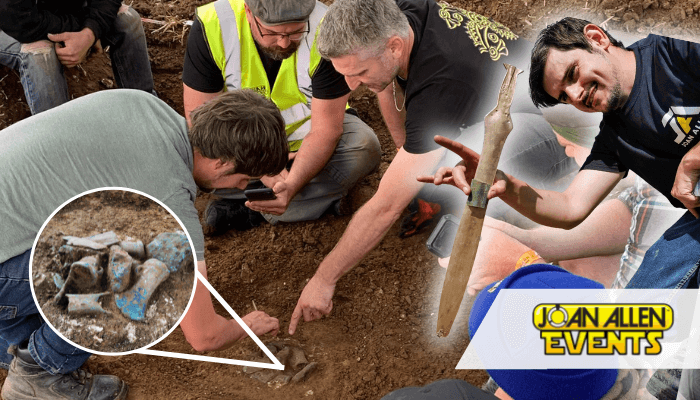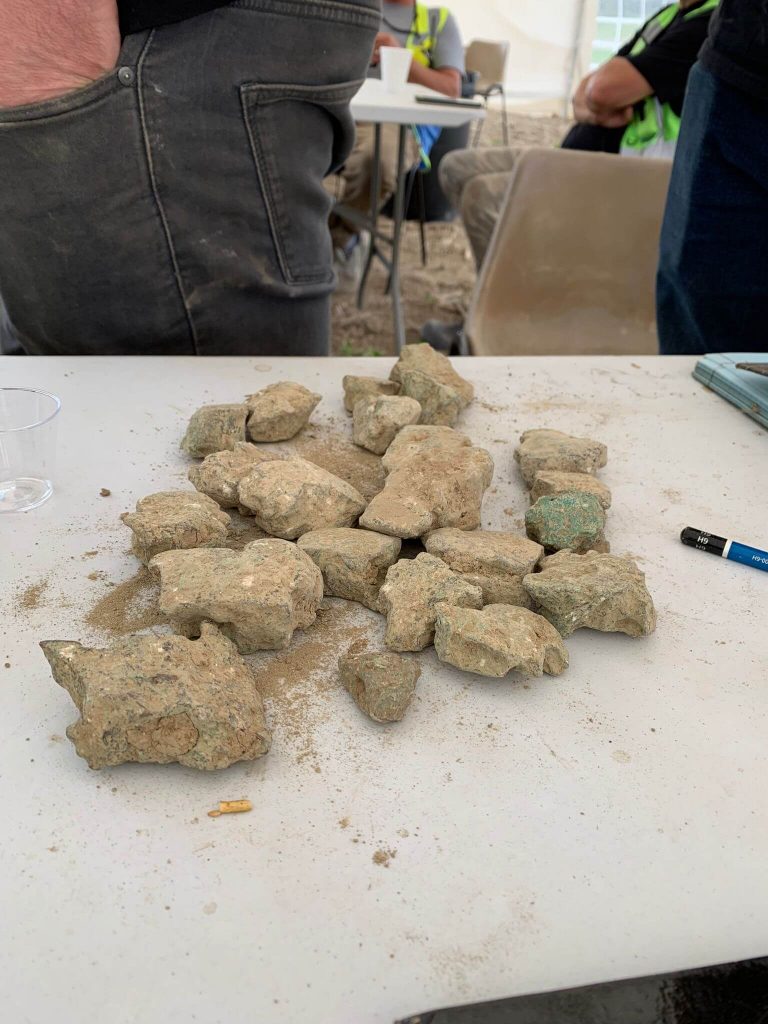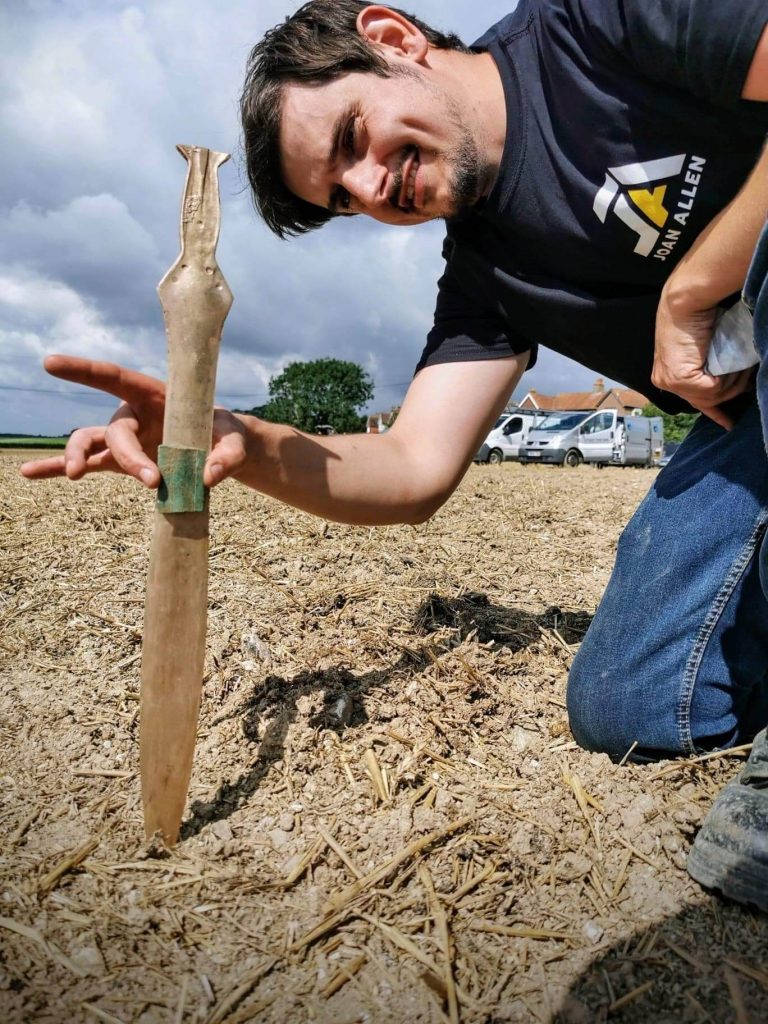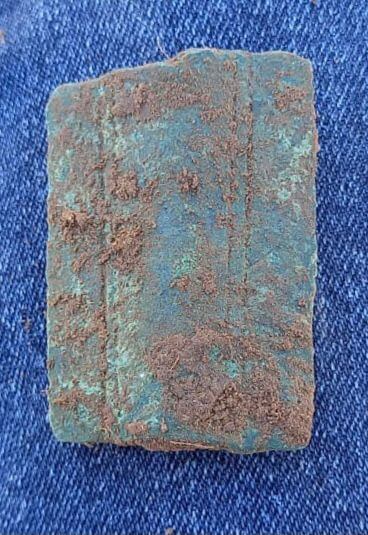Lenham, Kent - a weekend rally with Joan Allen Events by Danny Turvey with an analysis by Tom Lucking of the two hoards found whilst metal detecting.
In August, after a couple hours searching the first field, my friend Dan Hunt and I decided to try a different one. It was quite a walk so, very kindly, Luke Mahoney drove us and dropped us off close to the new field. We were later joined by our friends Matthew Walter and Walter Jr.
I had not been searching that long with my Minelab Equinox 800 (as we know one of many of the best metal detectors) when I heard a really high pitched tone – the screen was showing a solid 24. It was a very loud signal, too so I thought it had to be something interesting. I dug down about a foot before I saw a hint of green in the hole, which was a relief as I was starting to think it could had been some part of a plough or farm machinery!
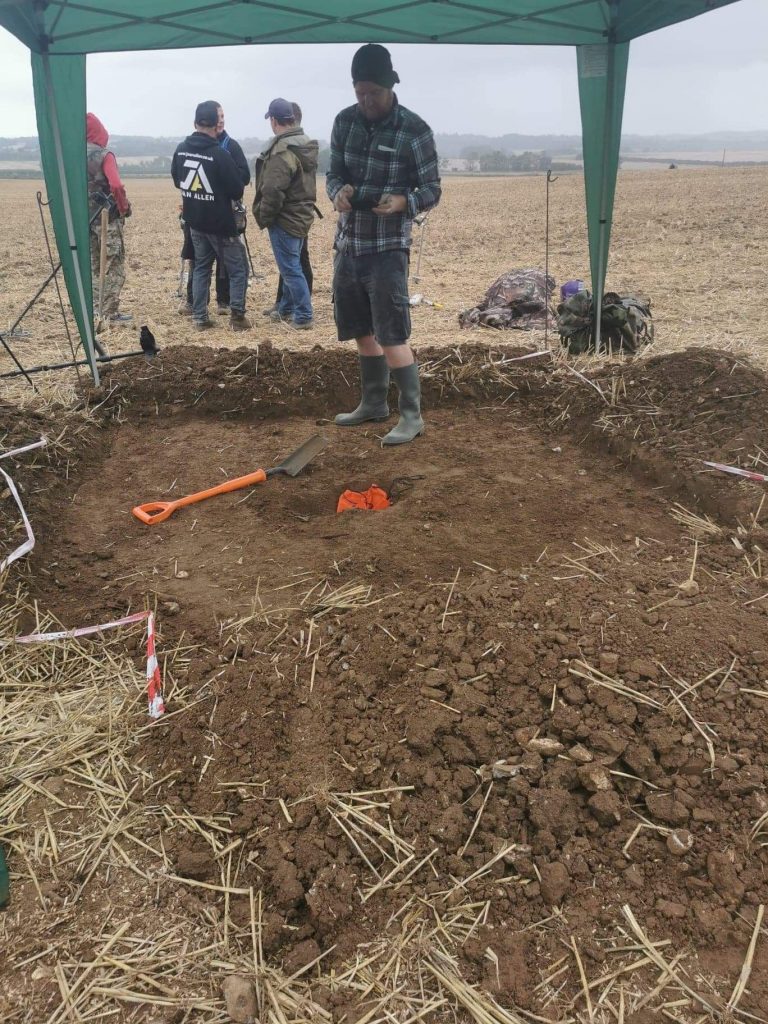
The first piece I uncovered was a small piece of broken sword (not identified by myself at the time). My pin pointer was still making a lot of noise around the area and I could see at least two other green ‘bits’. As I was digging, Walter came over to me and said I definitely had something ‘nice’. I immediately laid down my digging tools and got in touch with Luke, who kindly taped off the area as Mat and Walter had already found parts of bronze axes nearby. We were then joined by Chris from ‘Addicted to Bleeps’ and the well-known detectorist Adam Staples, who has an extensive knowledge of portable antiquities. It was all starting to feel very surreal!
Adam told me to contact the NCMD and the local archaeologist for advice as I had only been detecting for 15 months at the time and had never found anything considered significant until that point. I was really grateful for his help as I hadn’t got a clue and it would have taken me a lot longer to sort out on my own. The local archaeologist was unavailable, but we managed to get hold of Tom Lucking who has been, and remains, an active detectorist. Tom holds a Master’s degree in Landscape Archaeology and often uses his metal detector on archaeological digs in a professional role, so was the man for the job! He very kindly gave up his day and drove down from Norfolk – well over 2 1/2 hours away.
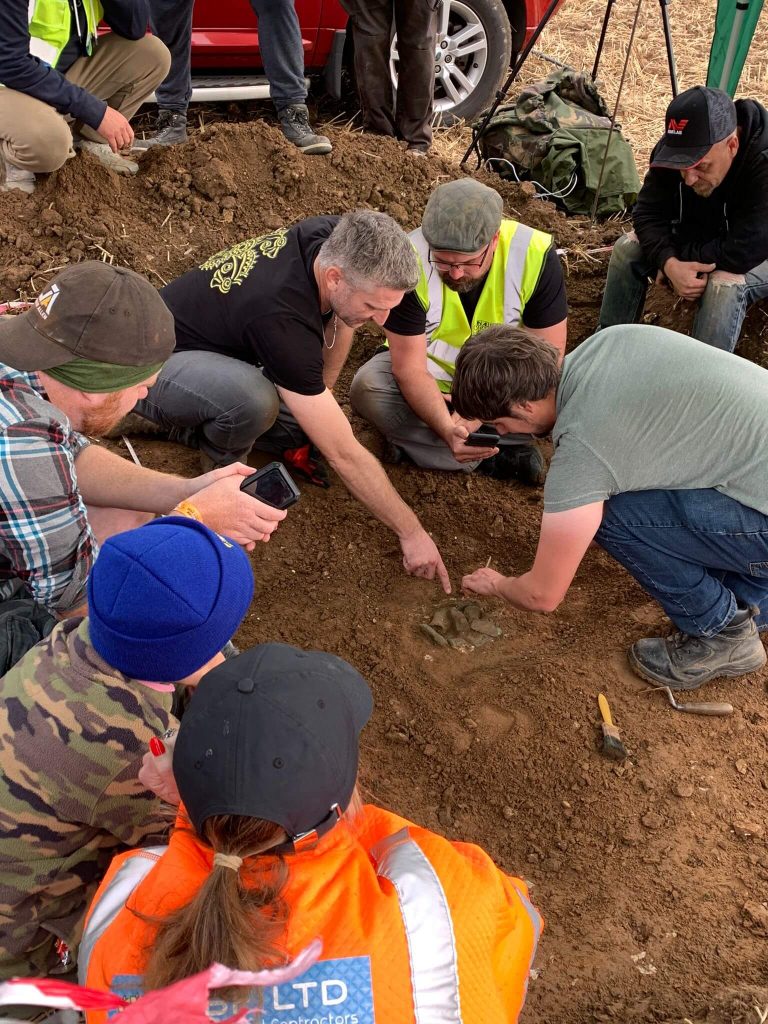
Adam and I started to prepare for Tom by taking the topsoil off in a 2 metre square around the original hole. When Tom arrived, Adam and Tom proceeded to scrape back to the hole and Tom meticulously cleaned around the area of the hole with a wooden cleaning implement - at this point he believed it was a founder’s Bronze Age hoard.
As Tom excavated the hoard, he very kindly allowed me to pick each piece out of the hole. I was so excited - I could not believe I was holding something over 3000 years old and it was incredible to think I was the first person to hold them since they’d been placed there. I started to wonder why – was it an offering to the Gods, or was it purely a deposit to be melted down later?
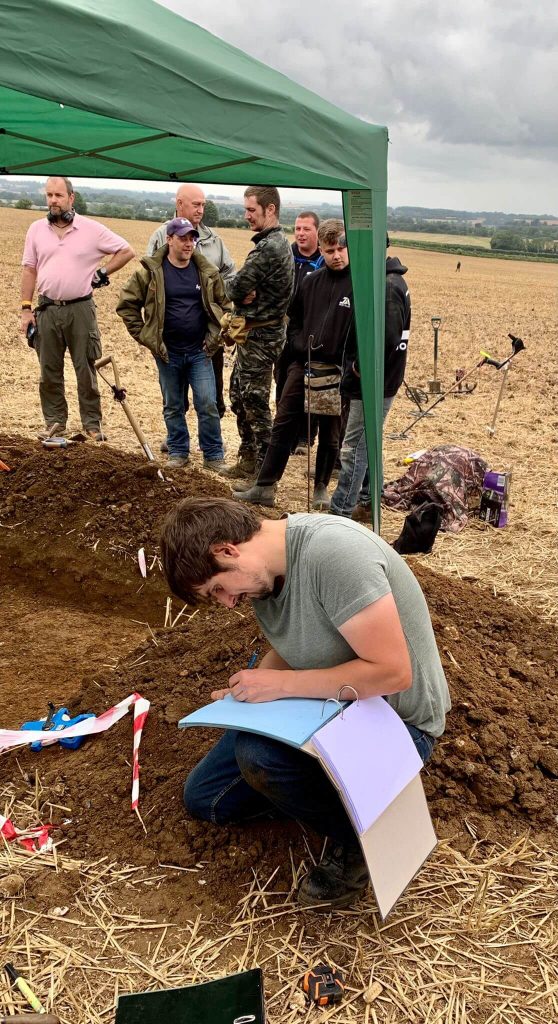
As we were thinking that we’d reached the end of the finds – there were more! I could not believe that one piece of the sword was still its original bronze colour as if was just made yesterday, which was amazing to see. The razor was my favourite piece and I was told it was an unusual shape.
There were 27 pieces in total we found whilst metal detecting: four complete axe heads, two incomplete swords and several axe pieces and a couple of ingots. Tom logged the hoard by drawing diagrams of each piece in situ and post excavation before bagging and labelling them.
Some other detectorists had found several bronze bits in the area which may be considered as part of this hoard.
Thanks to Joan Allen and Joan Allen Events for all their support – I’m extremely grateful they were there with me on my incredible discovery and journey.
It was a truly amazing experience. I was pumped with adrenaline and I will never forget this for the rest my life. I was so happy that it was streamed live via Facebook metal detection groups, so that other people could see and appreciate what was uncovered.
Definitely a day I won’t forget!
The Bronze Age metalwork recovered from the Lenham Metal Detector Rally included a consolidated founder’s hoard containing a range of objects, and a second scattered hoard of ingots a few hundred metres away. The discussion here focusses on the consolidated founder’s hoard, but the landscape context discussed in the final paragraph can be applied to both hoards.
The Lenham Hoard metal detection findings consists of a consolidated group of twenty-seven complete and incomplete objects of Late Bronze Age date, including fragments of at least two swords, two socketed spears, a minimum of seven socketed axes, at least one palstave axe, five bun ingot fragments, a small socketed hammer and an unusual razor blade or knife. The objects are either broken, with many showing deliberate signs of being hit with a hammer or similar tool or were fragments of objects that could potentially have broken in use. Few of the objects were in a useable state but some showed signs of having been used and re-sharpened before being broken up and added to the hoard. The objects had been tightly packed into a small pit, probably dug specifically for the deposition of this hoard which using professional digging tools we had no problem getting out.
Most of the objects had a bright green patina but a fragment of sword in the very base of the pit had been protected by the other objects and still retained its original brightly polished surface, providing a glimpse into how these objects would have looked when they were placed in the ground 3000 years ago.
As a group, this is a typical founder’s hoard of Late Bronze Age date (c.1000-800BC), containing a range of tool types that were widely produced at this time, or in the case of the palstave axe, an object that would already have been antique when it was added to the hoard. The term ‘founder’s hoard’ is an outdated term based on the assumption that hoards of this type represented scrap bronze that had been hidden with the intention of eventually recycling the material, due to the fact that many of these hoards contain incomplete or damaged objects. While some contemporary hoards may well have been intended for recycling, many of these hoards may also have a religious or ceremonial significance to them beyond simply being a collection of scrap, and the landscape context of the Lenham Hoard suggests that the material in this hoard was probably deliberately selected for deposition in a specific place.
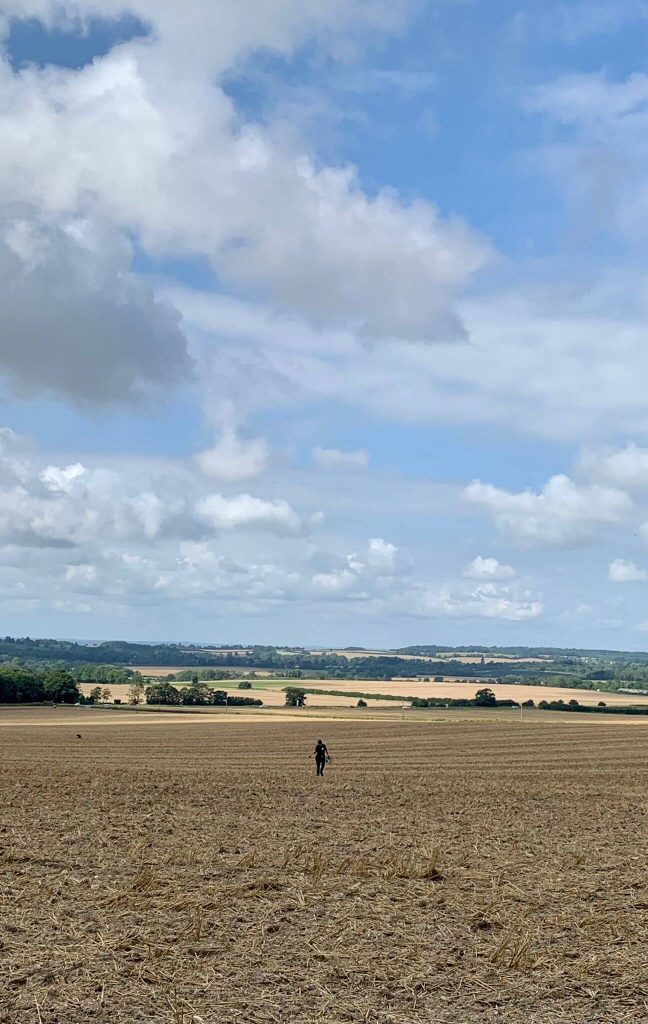
The location of the Lenham Hoard, and the scattered hoard of ingot fragments from the adjacent field, are not the only Bronze Age material to be recorded in the village. Metalwork of Middle and Late Bronze Age date has previously been recovered from a promontory overlooking a series of springs forming the source of the Great Stour. This material was included in a wider study of patterns of Bronze Age metalwork deposition in southern England (Yates and Bradley 2010). This study found that metalwork was often deposited in areas a short distance from a settlement in places where a change in the underlying geology was present, particularly where this change created spring lines in the landscape. Other locations included promontories overlooking river valleys and the confluences of rivers with the interpretation that there were ‘zones of metalwork’ in the landscape that were preferred for the deposition of hoards, and where it might be expected that they could be found. The finds from Lenham fit this model, with a changeable chalk geology (BGS 2022) underlying the hillside on which the metalwork was found, which also has a commanding view over the Great Stour valley. The Lenham Hoard therefore reinforces current understanding of the deposition of Bronze Age metalwork in Kent and wider southern England, demonstrating that the hoard site was not random, but a carefully selected place in the landscape that would have had significance for the local community.
References
British Geological Survey, Geology of Britain Viewer (2022). Website: https://mapapps.bgs.ac.uk/geologyofbritain/home.html. Accessed 4th March 2022.
Yates, D. and R. Bradley, ‘The Siting of Metalwork Hoards in the Bronze Age of South-East England’ in The Antiquaries Journal, Vol. 90 (2010): pp. 41-72.

